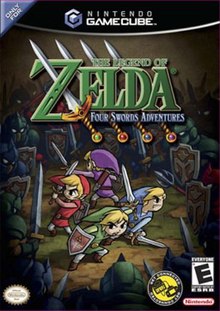
The Legend of Zelda is an action-adventure game franchise created by the Japanese game designers Shigeru Miyamoto and Takashi Tezuka. It is primarily developed and published by Nintendo, although some portable installments and re-releases have been outsourced to Flagship, Vanpool, and Grezzo. The gameplay incorporates action-adventure and elements of action RPG games.
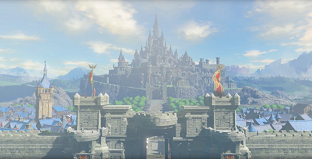
The Legend of Zelda is a video game franchise created by Japanese video game designers Shigeru Miyamoto and Takashi Tezuka and mainly developed and published by Nintendo. The universe of the Legend of Zelda series consists of various lands, the most predominant being Hyrule. The franchise is set within a fantasy world reminiscent of medieval Europe which consists of several recurring locations, races and creatures. The most prominent race in the series are the Hylians, a humanoid race with elfin features identifiable by their long, pointed ears. The series' lore contains a creation myth, several fictional alphabets, the most prominent being Hylian, and a fictional universal currency, the rupee. Most games in The Legend of Zelda series follow a similar storyline, which involves the protagonist Link battling monsters to save Princess Zelda and defeat a villain, which is often the series' main antagonist, Ganon. Nintendo developed the series' lore into a timeline that spans thousands of years across its history.
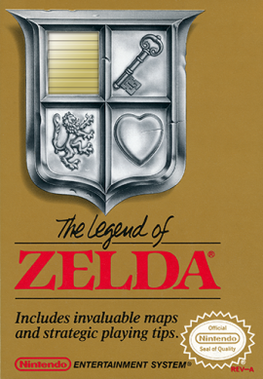
The Legend of Zelda, originally released in Japan as The Hyrule Fantasy: Zelda no Densetsu, is an action-adventure game developed and published by Nintendo. The first game of The Legend of Zelda series, it is set in the fantasy land of Hyrule and centers on an elf-like boy named Link, who aims to collect the eight fragments of the Triforce of Wisdom in order to rescue Princess Zelda from Ganon. The player controls Link from a top-down perspective and navigates throughout the overworld and dungeons, collecting weapons, defeating enemies and uncovering secrets along the way.

The Legend of Zelda: A Link to the Past is an action-adventure game developed and published by Nintendo for the Super Nintendo Entertainment System. It is the third game in The Legend of Zelda series and was released in 1991 in Japan and 1992 in North America and Europe.

The Legend of Zelda: The Wind Waker is an action-adventure game developed and published by Nintendo for the GameCube. An installment in The Legend of Zelda series, it was released in Japan on December 13, 2002, in North America on March 24, 2003, and in Europe on May 2, 2003.

The Legend of Zelda: Oracle of Seasons and The Legend of Zelda: Oracle of Ages are 2001 action-adventure games in the Legend of Zelda series. They were developed by Flagship and published by Nintendo for the Game Boy Color.
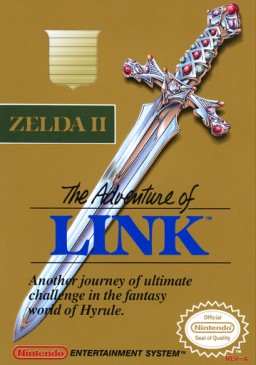
Zelda II: The Adventure of Link is an action role-playing game developed and published by Nintendo. It is the second installment in the Legend of Zelda series and was released in Japan for the Famicom Disk System on January 14, 1987—less than one year after the Japanese release and seven months before the North American release of the original The Legend of Zelda. Zelda II was released in North America and the PAL region for the Nintendo Entertainment System in late 1988, almost two years after its initial release in Japan.

The Triforce is a fictional artifact and icon of Nintendo's The Legend of Zelda video game franchise. It first appeared in the original The Legend of Zelda video game (1986) and has appeared in every subsequent game in the series. It consists of three equilateral triangles that are joined to form a large equilateral triangle. In the fictional history of the series, it represents the essence of the Golden Goddesses named Din, Nayru and Farore who create Hyrule. Imbued with divine power, it is capable of granting any wish to anyone who possesses it.

Princess Zelda is a character in Nintendo's The Legend of Zelda video game series. She was created by Shigeru Miyamoto for the original 1986 game The Legend of Zelda. As one of the central characters in the series, she has appeared in the majority of the games in various incarnations. Zelda is the elf-like Hylian princess of the kingdom of Hyrule, an associate of the series protagonist Link, and bearer of the Triforce of Wisdom.

Link is a character and the protagonist of Nintendo's video game franchise The Legend of Zelda. He was created by Japanese video game designer Shigeru Miyamoto. Link was introduced as the hero of the original The Legend of Zelda video game in 1986 and has appeared in a total of 20 entries in the series, as well as a number of spin-offs. Common elements in the series include Link travelling through Hyrule whilst exploring dungeons, battling creatures, and solving puzzles until he eventually defeats the series' primary antagonist, Ganon, and saves Princess Zelda.

Ganon is a character and the main antagonist of Nintendo's The Legend of Zelda video game series and franchise, as well as the final boss in many Zelda titles. In his humanoid Gerudo form, he is known as Ganondorf. A massive and malevolent pig-like creature, Ganon first appeared in the original The Legend of Zelda game in 1986, while his alter ego, Ganondorf, was introduced in Ocarina of Time. He has since appeared in the majority of the games in the series in various forms. He is the archenemy of the protagonist Link and Princess Zelda of Hyrule and originally the leader of the Gerudo, a race of humanoid desert nomads before becoming the ruler of his demon army.
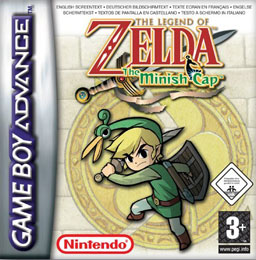
The Legend of Zelda: The Minish Cap is an action-adventure game and the twelfth entry in The Legend of Zelda series. Developed by Capcom and Flagship, with Nintendo overseeing the development process, The Minish Cap was released for the Game Boy Advance in Japan and Europe in 2004 and in North America and Australia the following year.
LCD games are electronic games played on an LCD screen. Since the release of the Zelda Game & Watch game in August 1989, several LCD games based upon the theme of The Legend of Zelda have been licensed by Nintendo to be released for both Japanese and foreign markets. While Zelda was both developed and manufactured by Nintendo, later LCD games would only be licensed by Nintendo. The Legend of Zelda game watch is an LCD wristwatch game produced by Nelsonic as part of their Nelsonic Game Watch series, and Zelda no Densetsu: Kamigami no Triforce is an LCD fighting video game licensed by Nintendo and produced by Epoch Co. for the Barcode Battler II platform, and released only in Japan.

The Legend of Zelda: Phantom Hourglass is a 2007 action-adventure game developed and published by Nintendo for the Nintendo DS handheld game console. It is the fourteenth installment in The Legend of Zelda series and the direct sequel to the 2002 GameCube title The Wind Waker. Phantom Hourglass was released worldwide in 2007, with the exception of South Korea in April 2008. The game was re-released for the Wii U via the Virtual Console service in the PAL region in November 2015, in North America in May 2016, and in Japan in August.

Midna is a fictional character in Nintendo's The Legend of Zelda series, introduced as one of the main protagonists in Twilight Princess. She is a member of the magic-wielding Twili who joins forces with Link to prevent the kingdom of Hyrule from being enveloped by a corrupted parallel dimension known as the Twilight Realm. While Midna appears as an imp-like creature in the majority of Twilight Princess, her actual form is humanoid. She was designed by Yusuke Nakano and voiced by Akiko Kōmoto. Midna also appears as a playable character in Hyrule Warriors, and makes minor appearances in the Super Smash Bros. series.
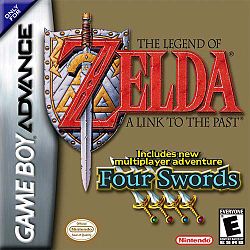
The Legend of Zelda: A Link to the Past and Four Swords is a compilation of two action-adventure games co-developed by Nintendo R&D2 and Capcom and published by Nintendo for the Game Boy Advance. The game was released in December 2002 in North America and in March 2003 in Japan and Europe. The cartridge contains a modified port of A Link to the Past, originally released for the Super Nintendo Entertainment System in 1991, and an original multiplayer-only game titled Four Swords, which serves as the 9th installment in The Legend of Zelda series.

Navi is a fictional fairy who acts as series protagonist Link's navigator throughout the 1998 Nintendo 64 video game The Legend of Zelda: Ocarina of Time. She was voiced by Kaori Mizuhashi. Navi performs a variety of functions within the game, including being a companion and guide to Link, providing the player with advice and being a focal point for the game's Z-lock targeting combat system. Other characters in The Legend of Zelda series have served in similar roles, including Tatl, Midna, and Fi. When designing the reticle for the game, designer Yoshiaki Koizumi made a ball of light with wings, naming it "Fairy Navigation System" before naming it Navi. She has been widely criticised by players and critics for her repetitive interruptions in gameplay, particularly with the prompt "Hey! Listen!", though some have argued that she was a valuable companion in the game.
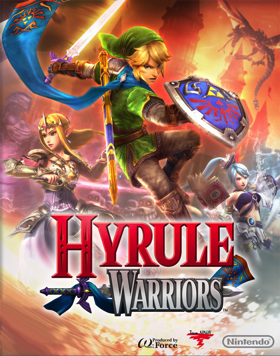
Hyrule Warriors is a hack and slash video game developed by Omega Force and Team Ninja for the Wii U video game console. The game is a collaboration between Koei Tecmo and Nintendo, mixing settings and characters from Nintendo's The Legend of Zelda with the gameplay of Koei's Dynasty Warriors series. Hyrule Warriors was released in Japan in August 2014, and worldwide the following month. It became one of the best-selling games on the Wii U. An updated port, Hyrule Warriors Legends, was released for the Nintendo 3DS in Japan in January 2016 and worldwide in March of the same year. A second enhanced port, Hyrule Warriors: Definitive Edition, was released for the Nintendo Switch in 2018. A successor, Hyrule Warriors: Age of Calamity, was released exclusively for the Nintendo Switch in November 2020.
